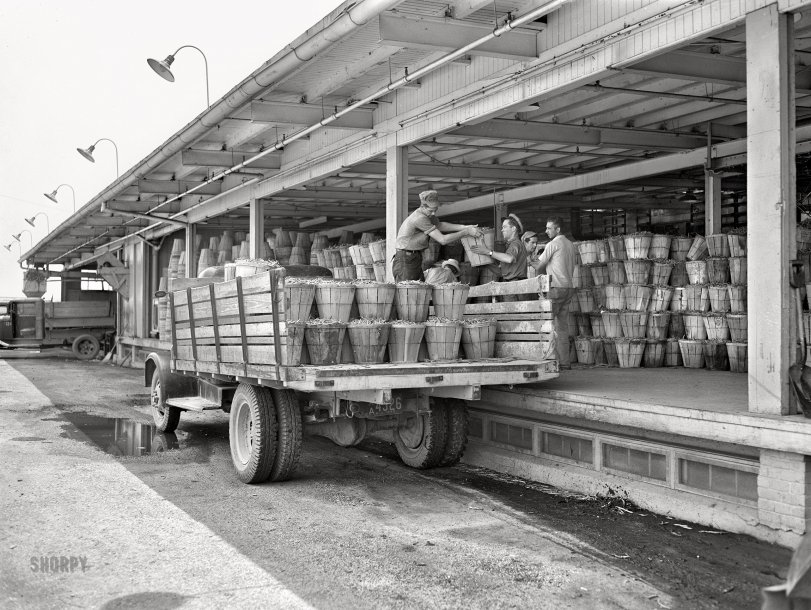


Framed or unframed, desk size to sofa size, printed by us in Arizona and Alabama since 2007. Explore now.
Shorpy is funded by you. Patreon contributors get an ad-free experience.
Learn more.

- Roll your own
- Rugged and real!
- A Charles Purcell - Mama Cass Connection
- Uncle SAAM
- Obfuscation
- One Chocolate Soldier rode away
- Victor Marquis de la Roche
- The Little House Across Way ...
- Vanderbilt Gates
- Vanderbilt Mansion
- You can still see that gate
- Withering heights for me
- So Jim,
- Top Heavy
- Re: Can't Place It.
- Bus ID
- Since you mention it
- The White Pages ?
- Moonlight Tower
- 1907?
- Fire(men) and Water
- Can't Place It
- Can anyone
- Wings
- Where's Claudette and Clark?
- Overbuilt Rolodex
- One song
- Give Me Wings Please!
- PRR
- Pinball Wizards
Printporium
Cool Beans: 1942

June 1942. Bridgeton, New Jersey. "Seabrook Farms, several thousand acres, where Birdseye Foods are produced. Loading beans onto the delivery platform of the packing plant." 4x5 inch acetate negative by John Collier for the Farm Security Administration. View full size.
Birdseye view
The Birdseye clue sent me to this page. Seabrook Farms was already a large vegetable farm when it partnered with Clarence Birdseye and General Foods to produce Birdseys frozen vegetables. They were also a major supplier of vegetables to the U.S. military during WWII. As more of their regular workforce joined the war effort (or found better employment), Seabrook pulled workers from wherever they could find them. They used German prisoners, offered a work alternative to the inmates at Japanese internment camps, employed displaced persons from across Europe, and more. The farm disappeared in sales and corporate buy outs, but some descendants of the original owners have revived name and are back in the frozen veggie business.
They know what they're doing
loujudson makes a good point. His point reminded me that I indirectly commented there should have been a more efficient way to unload this corn. Maybe when you do as much physical labor as they did, this part wasn't worth thinking about too much. I'm also reminded of doing it the difficult way when the product was concrete.
AxelK's comment made me take another look and first wonder why one of the men on the loading dock doesn't simply step on the bed of the truck and make two on the truck handing off to two on the dock.
Then I realized they're probably passing the baskets like a water brigade. The baskets aren't that heavy and forming a line keeps the men from bumping into each other and makes for an orderly stacking on the dock. That would also explain why the truck is parked parallel to the dock, so close the truck bed overlaps the dock. As AxelK said, you first assume they know what they're doing.
Why the truck might be side-to
Having unloaded a variety of goods from trucks in my more respectable days, and assuming this truck wasn't aligned as shown to accommodate the fotog, I suspect it's because (1) baskets of string beans aren't terribly heavy (versus, e.g., tomatoes or potatoes), so the side rails aren't a big issue, and (2) turning and getting a new basket with a step or two might be less time-consuming than walking back and forth along the long axis of the truck bed as unloading progressed, and (3) the guys on the dock can reposition themselves as the offloader clears an area, keeping remaining baskets within his easy reach. My default assumption is that guys like these know what they're doing. However, I yield to any time-and-motion geeks in the audience.
Staged for the photographer?
In response to loujudson's question of why they didn't back the truck up to the dock, that wouldn't have made for nearly as interesting a photo. I wonder if John Collier asked them to park the truck this way so he could get the photo he wanted.
[No. *Sigh* - Dave]
Bushels and bushels!
I would've backed the truck up to the platform and unloaded from the back! Why lift them over the rails? Then the four guys could help the one in the truck. But then, the only comparable experience I have had was mail trucks, dragging sacks by the ropes. Did they have some rule to do it this way?
























On Shorpy:
Today’s Top 5